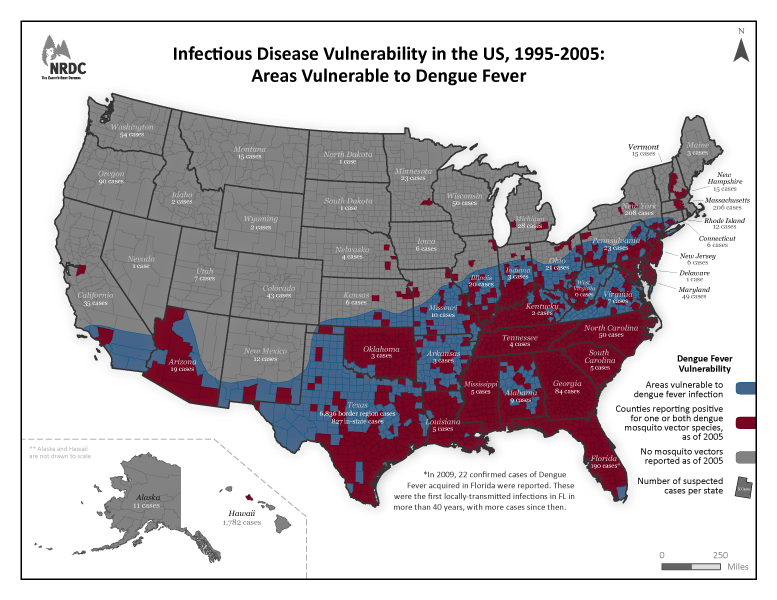Vector-Borne Diseases
Vector-borne Diseases
According to the Virginia Board of Health, a ‘vector-borne disease’ is any condition “caused by an infectious microbe transmitted to people by blood-sucking arthropods. Historically, vector-borne diseases have been recorded in various climates. However, the Centers for Disease Control (CDC) has recently noted that, as an indirect result of climate change, the number of U.S. patients diagnosed with diseases normally found in warmer regions is steadily increasing.
Infectious Disease Vulnerability in the U.S. (1995-2005)

Image via The National Resource Defense Council. High temperatures and extreme weather patterns are conducive to mosquito breeding, and cases of mosquito-borne illnesses have been on the rise in the U.S. (most notable the Southeastern states).
- West Nile virus: The first cases of West Nile virus in the U.S. were reported in 1999; six years later, more than 16,000 patients had been diagnosed with the disease. “Warmer temperatures, heavy rainfall and high humidity have reportedly increased the rate of human infection,” notes NRDC.
- Dengue fever: In 2009, a case of dengue fever was reported in Florida for the first time in roughly 75 years; 27 more cases were reported in an outbreak that lasted for one year. Today, NRDC notes that mosquitoes capable of carrying and transmitting the disease have been found in 28 states, as well as Puerto Rico, where NRDC notes were reported in 2010 alone. Dengue fever affects as many as 400 million people worldwide every year, and is commonly diagnosed throughout the Caribbean and other tropical regions.
- Chikungunya: A research study published in the International Journal of Health Geographics also posited the theory that climate change will precipitate a resurgence of the mosquito-borne disease known as “chikungunya” in the years to come. According to Nature World News, cases of chikungunya were reported in three Florida counties in Spring 2014; there is currently no cure for the disease.
- Malaria: Earlier this year, researchers at the University of Michigan published a report citing fears of future malaria outbreaks in the United States; currently, domestic cases are rare and most Americans diagnosed with the mosquito-borne disease acquire it overseas, but malaria has been known to migrate to higher altitudes when global temperatures rise. Malaria annually claims more lives worldwide than any other disease.
Tick and Flea-Borne Illness
In addition to mosquitoes, ticks are responsible for a significant number of vector-borne disease cases. The CDC lists 14 primary tick-borne diseases found throughout the U.S., including Lyme disease, which is classified as the most commonly diagnosed vector-borne disease in the country.
Historically, the vast majority of Lyme disease diagnoses have been compartmentalized to 13 states in the Midwest and Northeast. At least 20,000 cases have been reported in the U.S. each year since 2005; in 2009, the number reached 30,000. If the temperatures and levels of humidity continue to increase, researchers at Montana State University fear a major increase in Lyme disease cases due to a widespread “acceleration of the tick’s developmental cycle.” The NRDC has also noted that Lyme disease “could expand throughout the United States and northward into Canada, as temperatures warm, allowing ticks to move into new regions.”
Finally, epidemiologists around the world have noted a rise in the incidence rate of vector-borne diseases spread by fleas. A 2009 article published in the International Journal of Infectious Diseases noted that flea-borne diseases may reach epidemic proportions as a combined result of climate change and destruction of wild habitats due to human development. Like ticks, fleas thrive in warm, humid climates. The five authors of the article note that increased temperatures will inevitably lead to an expansion of flea vectors into the northern hemispheres. “Climate change, and our continued encroachment on natural areas, may provide new lines of transmission for a largely unknown pathogen population of wild fleas.”
Although all of the diseases listed above have been known to affect relatively healthy patients of all ages, children, the elderly, and chronically ill individuals are considered the most vulnerable to vector-borne infection (particularly those who reside in southern states). Furthermore, these diseases are most commonly reported during the warmest, most humid periods of the year; in the U.S., this generally coincides with mid-to-late summer ― although, as noted above, climate change could expand the window period during which U.S. residents are highly susceptible to vector-borne diseases.
